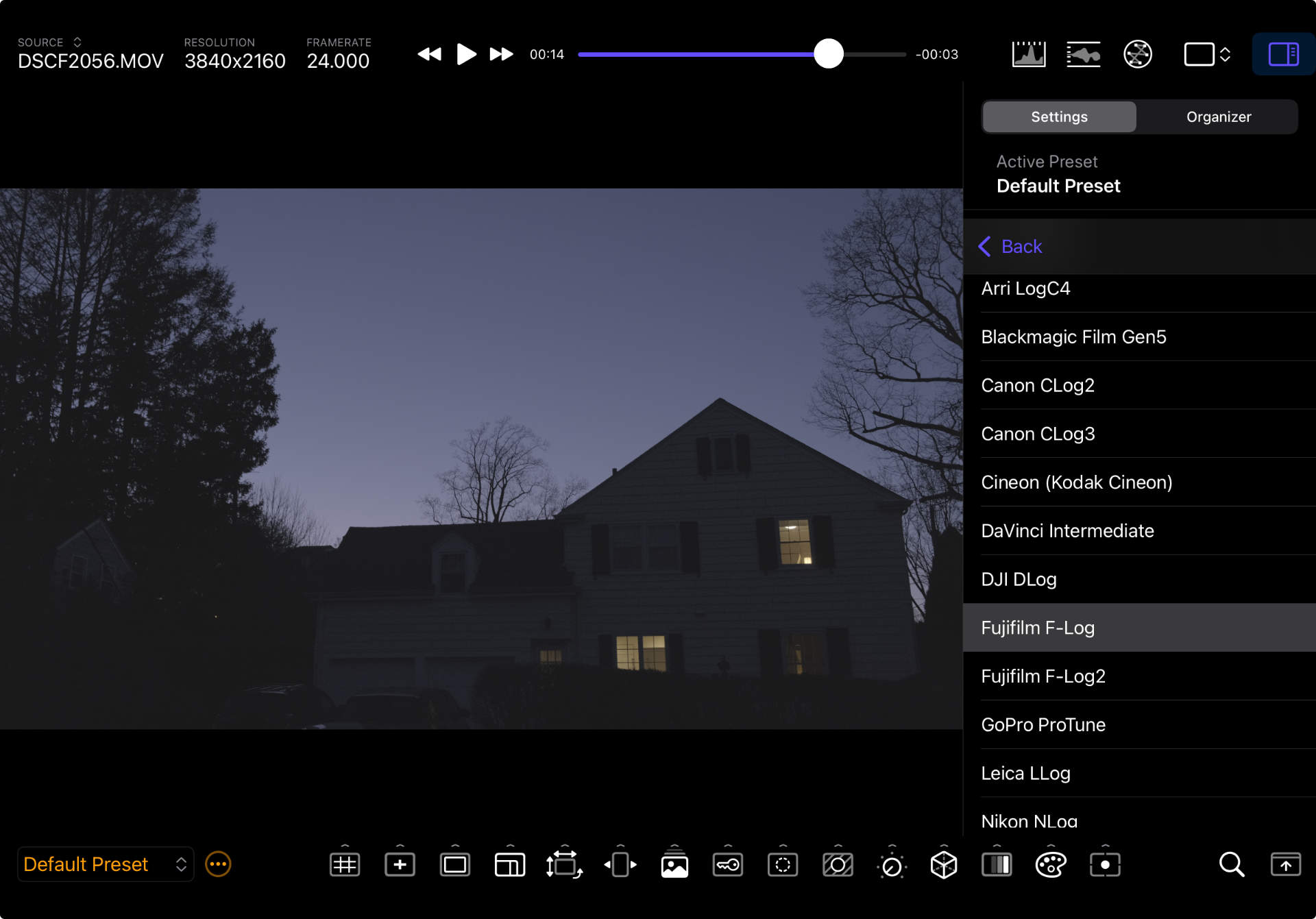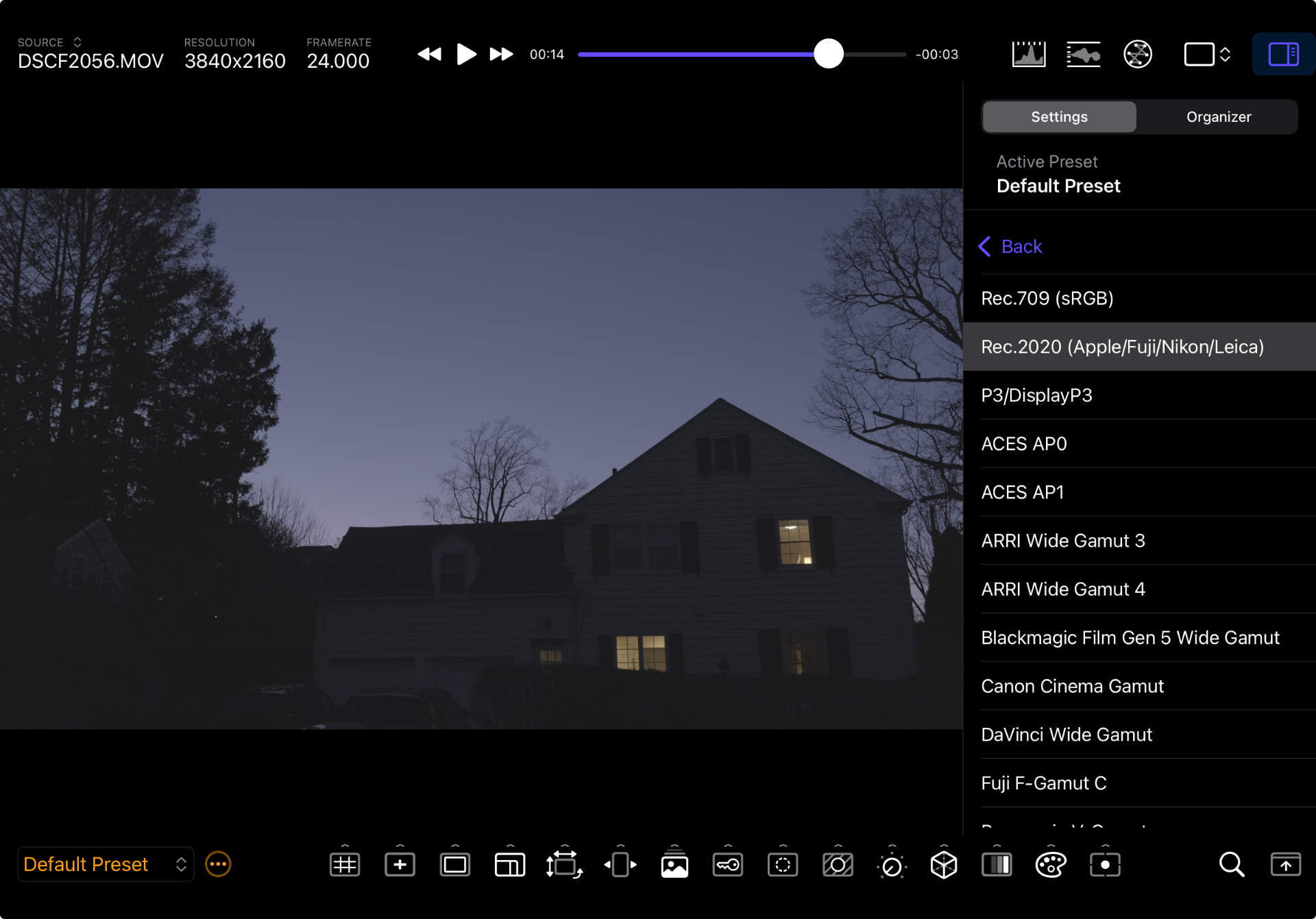Color Management

Overview
This is an advanced topic that only applies to input signals that are in a log format, and is only available in PRO. If your input signal is already in a display format (e.g. Rec.709), feel free to skip this whole section.
Some CineMon monitoring functions work in linear light. This works best when the input signal provides a wide dynamic range of tonal and color values, which is usually accomplished by encoding the signal using a log curve and a wide color gamut.
Use Preset Settings to configure your input signal’s Input Gamma and Input Gamut. This will ensure that CineMon’s photometric features work correctly with your video.
Color Space Transform (CST)
CineMon supports a Color Space Transform (CST) function that converts the input signal’s gamma and gamut (Color Space) to a destination space (e.g., ARRI LogC4/ARRI Wide Gamut → Rec.709/BT.709). Some professional video editing and color correcting applications offer similar capabilities, also known as Display Rendering Transforms (DRTs). CineMon’s CST functions are GPU-accelerated, mathematical functions built from official camera vendor specifications for their supported log curves, and color primaries.

When the CST is turned on, the processing happens right after the Calibration LUT is applied, and before any other image manipulation.
Features dependent on linear light processing, such as the Spot Meters and Test Strip will tap the image before the CST is applied.
This feature is commonly used to convert from a camera log profile (e.g. Sony SLog3/SGamut3.Cine), also known as a Scene Referred color space, to a range of tones and colors that look better on standard screens, also known as Display Referred space (e.g. Rec.709).
Scene referred signals usually look flat and washed out, with low color saturation, which can make it more difficult to monitor on set. Applying a CST is a dependable, clinical way to preview the image, without introducing a creative look bias.
Another popular way of achieving a similar result is by applying a Display Lookup Table (LUT), which CineMon supports. However, because of how LUTs work, they always involve a certain amount of creative manipulation by the author. So the transformed image often deviates from the pure mathematical precision of a CST, which may be what you want.
We recommended that you test your Color Management workflow end-to-end before deciding which method is the best fit for your project.
You can still layer a Display LUT after a CST for a creative look. In fact, many popular Display LUTs are built assuming the base image is in a specific Log Space (e.g.
ARRI LogC3orCineon). The CST doesn’t need to convert from a scene referred gamma to a display referred one. You can convert from a camera-specific log curve (e.g.VLog/V-Gamut) to a different one (e.g.Cineon), to use as a base for further processing. These transforms are high-precision (64-bit), GPU-accelerated math functions that don’t introduce any signal quality loss.
Supported Log Profiles
| Type | Description | Values |
|---|---|---|
| Gamma* | Supported gamma curves. | Rec.709, ACEScc, ACEScct, Apple Log, ARRI LogC3, ARRI LogC4, Blackmagic Film Gen5, Canon CLog2, Canon CLog3, Kodak Cineon, DaVinci Intermediate, DJI DLog, Fujifilm F-Log, Fujifilm F-Log2, GoPro ProTune, Leica LLog, Nikon NLog, Panasonic VLog, Red Log3G10, Sony SLog2, Sony SLog3 |
| Color Space (Gamut) | Supported color spaces or gamuts. | Rec.709/sRGB, Rec.2020 (Apple/Fujifilm/Nikon/Leica), DisplayP3, ACES AP0, ACES AP1, ARRI Wide Gamut 3, ARRI Wide Gamut 4, Blackmagic Film Gen5 Wide Gamut, Canon Cinema Gamut, DaVinci Wide Gamut, Fujifilm F-Gamut C, Panasonic V-Gamut, Red Wide Gamut, Sony SGamut3.Cine, Sony SGamut3, Sony Venice SGamut3.Cine, Sony Venice SGamut3 |
Associated Preset Settings:
| Type | Description | Values |
|---|---|---|
| Apply Color Space Transform | Activates a Color Space Transform (CST) or Display Rendering Transform (DRT) from the Input Gamma and Color Space to the Output Gamma and Color Space. | On/Off |
| Tone Mapping | Applies a tone mapping function to compress higher dynamic range values to fit in the destination color space. | On/Off |
| Preserve Saturation | Modifies the tone mapping function to preserve saturation values. | On/Off |
| Gamut Compression | Compresses color values from a larger gamut to fit the a smaller destination gamut. | On/Off |
Input Gamma Notes
The following tools are photometrically accurate only if the input signal is in a scene referred gamma, and if the Input Gamma setting matches the input image’s log curve:
- Spot Meters
- Test Strip
- Exposure Adjust
- Color Space Transform
If the input image is not in a log format (e.g. Rec.709), or the Input Gamma setting is not properly configured, these tools will report inaccurate exposure levels.